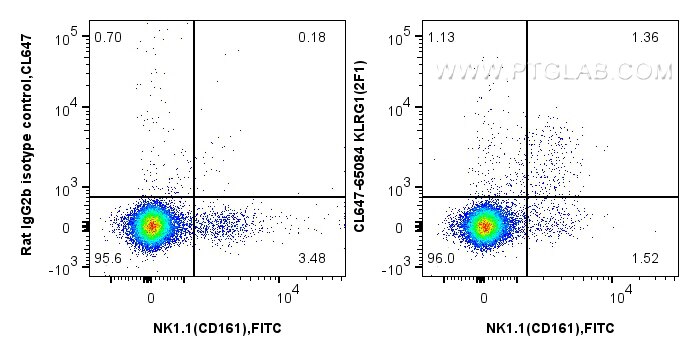KLRG1 Monoklonaler Antikörper
KLRG1 Monoklonal Antikörper für FC
Wirt / Isotyp
Golden Syrian Hamster / IgG
Getestete Reaktivität
Maus
Anwendung
FC
Konjugation
CoraLite® Plus 647 Fluorescent Dye
CloneNo.
2F1
Kat-Nr. : CL647-65084
Synonyme
Geprüfte Anwendungen
| Erfolgreiche Detektion in FC | Maus-Splenozyten |
Empfohlene Verdünnung
| Anwendung | Verdünnung |
|---|---|
| This reagent has been tested for flow cytometric analysis. It is recommended that this reagent should be titrated in each testing system to obtain optimal results. | |
| Sample-dependent, check data in validation data gallery | |
Produktinformation
CL647-65084 bindet in FC KLRG1 und zeigt Reaktivität mit Maus
| Getestete Reaktivität | Maus |
| Wirt / Isotyp | Golden Syrian Hamster / IgG |
| Klonalität | Monoklonal |
| Typ | Antikörper |
| Immunogen | k.A. |
| Vollständiger Name | killer cell lectin-like receptor subfamily G, member 1 |
| GenBank-Zugangsnummer | BC101953 |
| Gene symbol | Klrg1 |
| Gene ID (NCBI) | 50928 |
| Konjugation | CoraLite® Plus 647 Fluorescent Dye |
| Excitation/Emission maxima wavelengths | 654 nm / 674 nm |
| Form | Liquid |
| Reinigungsmethode | Affinitätsreinigung |
| Lagerungspuffer | PBS with 0.09% sodium azide and 0.5% BSA |
| Lagerungsbedingungen | Store at 2-8°C. Avoid exposure to light. Stable for one year after shipment. |
Hintergrundinformationen
KLRG1 (killer cell lectin-like receptor subfamily G, member 1) is a C-type lectin inhibitory receptor that contains an immunoreceptor tyrosine-based inhibitory motif (ITIM) in its cytoplasmic domain. KLRG1 is expressed by subsets of NK and T cells, existing both as a monomer and as a disulfide-linked homodimer (PMID: 10741410; 19604491). It is considered to be a cell differentiation marker for NK and T cells and is strongly induced by viral and other infections (PMID: 20373518). Through interactions with members of the cadherin family, KLRG1 plays an inhibitory role on NK- and T-cell function (PMID: 19009530; 20373518).
Protokolle
| PRODUKTSPEZIFISCHE PROTOKOLLE | |
|---|---|
| FC protocol for CL Plus 647 KLRG1 antibody CL647-65084 | Download protocol |
| STANDARD-PROTOKOLLE | |
|---|---|
| Klicken Sie hier, um unsere Standardprotokolle anzuzeigen |


